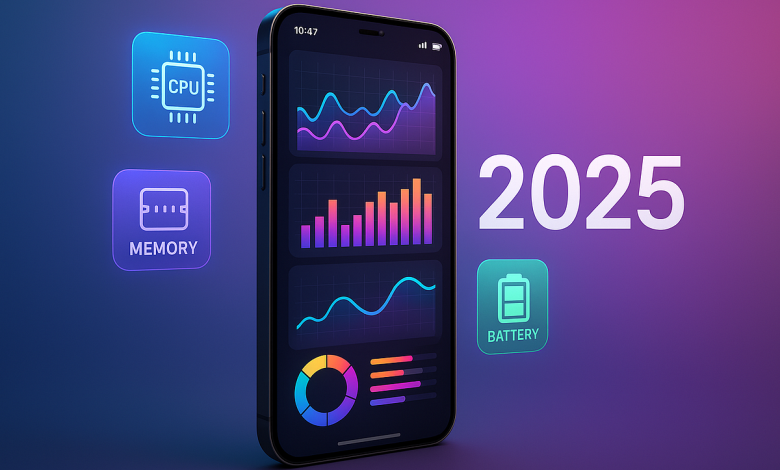Optimizing Mobile App Performance and Reducing Memory Usage

In today’s competitive mobile landscape, performance is king. Users expect apps to load quickly, run smoothly, and consume minimal battery and memory. In fact, research shows that 53% of users abandon apps that take more than 3 seconds to load, and poor performance is one of the main reasons users uninstall applications.
For developers, optimizing app performance and reducing memory usage is not just a technical requirement—it’s directly tied to user retention, app store ratings, and overall business success.
This article provides a comprehensive guide to mobile app performance optimization in 2025, covering best practices, tools, and techniques for both Android and iOS platforms.
Why Performance Optimization Matters
- User Experience (UX): Slow apps frustrate users, leading to abandonment.
- Battery Efficiency: Optimized apps drain less power, keeping users engaged.
- Device Limitations: Many users in emerging markets rely on low-to-mid-range devices with limited memory.
- App Store Rankings: Performance issues can hurt ratings and visibility.
- Competitive Advantage: Fast, efficient apps stand out in crowded markets.
Key Areas of App Performance Optimization
1. App Startup Time
- Minimize unnecessary processes during launch.
- Use lazy loading for resources (load them only when needed).
- For Android: Optimize the Application class and reduce initializations.
- For iOS: Defer heavy tasks from
application(_:didFinishLaunchingWithOptions:).
2. Memory Management
- Release unused objects quickly.
- Use weak references where appropriate to avoid memory leaks.
Monitor memory usage using:
- Instruments (Leaks & Allocations) in Xcode
- Android Profiler in Android Studio
3. Network Optimization
- Implement caching for static resources.
- Use pagination and lazy loading for lists.
- Compress data using formats like gzip or protobuf.
- Minimize API calls by batching requests.
4. Rendering and UI Performance
- Avoid unnecessary re-renders.
Use efficient layouts:
- ConstraintLayout or Jetpack Compose on Android
- SwiftUI or Auto Layout on iOS
- Optimize images by using appropriate formats and resolutions.
- Use GPU acceleration wisely for animations.
5. Background Processes
Schedule background tasks using:
- BackgroundTasks framework on iOS
- WorkManager on Android
- Avoid keeping unnecessary services running in the background.
Tools for Measuring App Performance
Android
- Android Profiler: Memory, CPU, and network usage analysis.
- LeakCanary: Detects memory leaks automatically.
- Firebase Performance Monitoring: Real-time performance metrics.
iOS
- Instruments (Xcode): CPU, memory, energy diagnostics.
- XCTest Performance Metrics: Benchmarking app performance.
- OSLog & Console: Real-time debugging.
Cross-Platform
- New Relic Mobile
- AppDynamics
- Sentry Performance Monitoring
Best Practices for Reducing Memory Usage
Optimize Images & Media
- Stream large media instead of preloading.
- Compress images using tools like WebP.
- Use vector graphics (SVG, PDF) where possible.
Efficient Data Structures
- Choose the right data structures (e.g., HashMap over ArrayList for lookups).
- Avoid holding large datasets in memory—use local storage or databases.
Avoid Memory Leaks
- In iOS, prevent retain cycles with
[weak self]in closures. - In Android, watch out for Context leaks.
- Dispose of Resources Properly
- Release heavy objects when no longer needed.
- Cancel unused network requests.
- Close database connections.
Case Study: Improving Startup Time by 40%
A fintech company noticed that its Android app was taking 6 seconds to start, leading to high churn rates. After profiling, they discovered:
- Multiple SDKs were initializing on startup.
- Images were being preloaded unnecessarily.
Fixes Applied:
- Moved SDK initializations to background threads.
- Implemented lazy loading for non-essential images.
- Reduced startup time from 6s → 3.5s, resulting in 15% higher user retention.
Energy Consumption and Battery Optimization
Performance optimization isn’t only about speed—it’s also about battery efficiency.
- Minimize wake locks and background services (Android).
- Reduce background fetch frequency (iOS).
- Batch network requests to minimize radio use.
- Avoid unnecessary polling—use push notifications instead.
Performance in Cross-Platform Frameworks
Flutter
Avoid rebuilding the entire widget tree unnecessarily.
- Use
constconstructors for widgets. - Optimize list views with
ListView.builder.
React Native
- Minimize bridge usage between JS and native code.
- Use FlatList instead of ScrollView for long lists.
- Consider native modules for heavy computations.
Checklist for Developers
✅ Profile app regularly with official tools
✅ Optimize startup sequence
✅ Release unused memory immediately
✅ Use efficient data structures
✅ Minimize network overhead
✅ Optimize media and assets
✅ Test on low-end devices, not just flagships
Conclusion
In 2025, app performance and memory efficiency are no longer optional—they are core success factors for mobile applications. Developers who prioritize optimization will enjoy:
- Higher user satisfaction
- Better app store ratings
- Improved retention and engagement
Whether you’re building a native iOS/Android app or using cross-platform frameworks like Flutter and React Native, the principles remain the same: measure, optimize, and iterate continuously.
By following these best practices, you’ll ensure your app delivers a smooth, responsive, and energy-efficient experience—keeping users happy and loyal.

